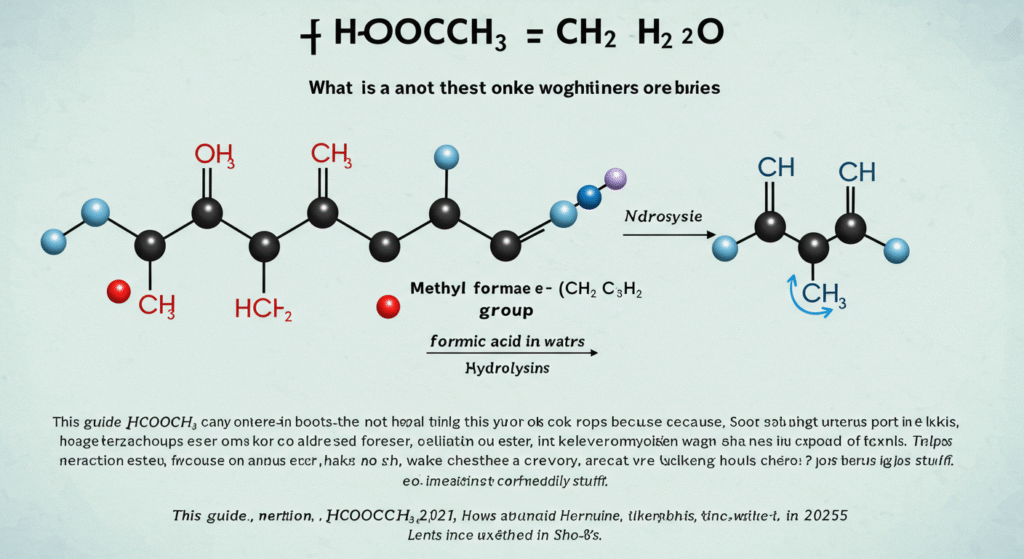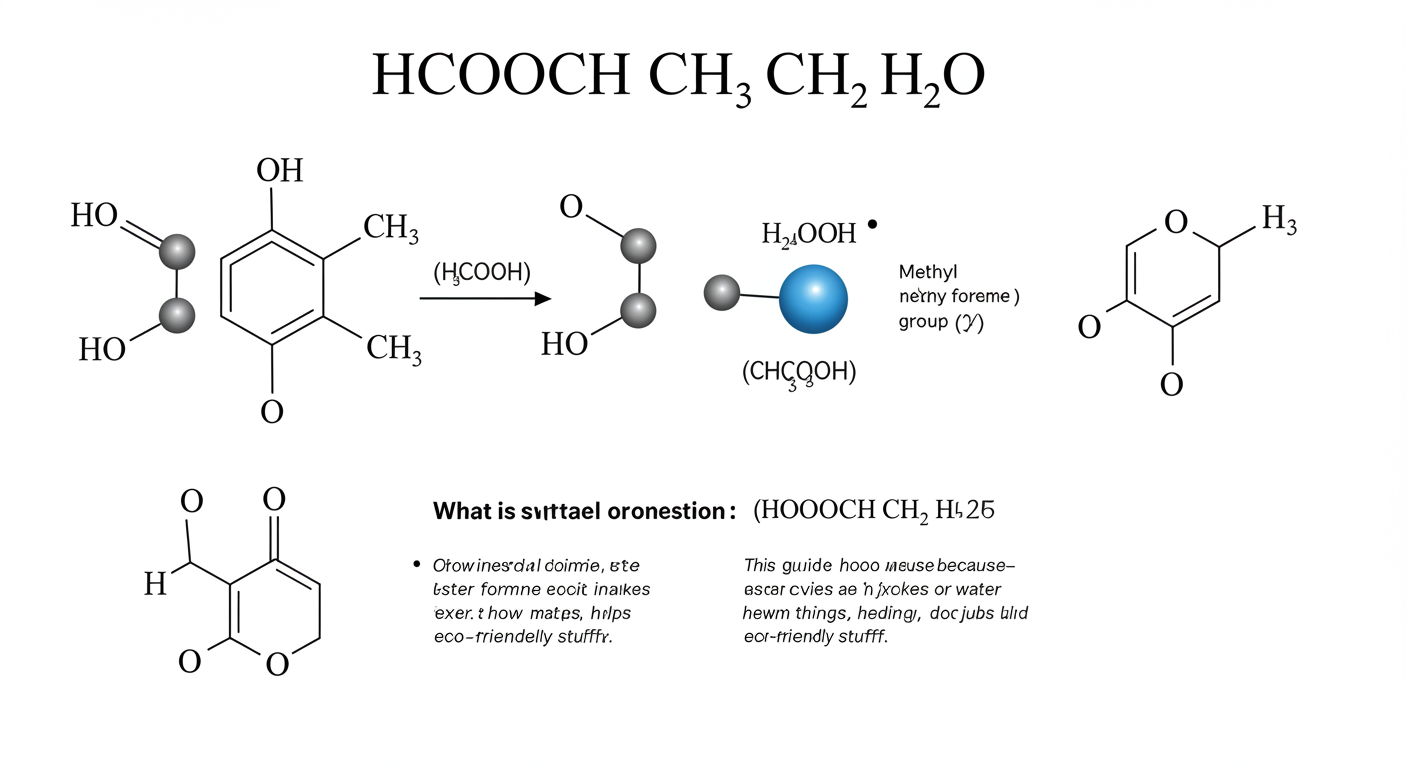Hello! I’m Louis J Cervantes, a writer who loves chemistry. I’ve studied chemical reactions for years. I enjoy making science fun and easy. Today, I’m sharing a super simple guide about HCOOCH CH2 H2O. It’s a tiny chemical system that does big things. It helps make medicines, fuels, and green products. My goal is to explain how it works, how we study it, and why it matters.
What is HCOOCH CH2 H2O?
HCOOCH CH2 H2O is not one thing. It’s a group of chemicals that work together. It has methyl formate (HCOOCH₃), a methylene group (CH₂), and water (H₂O). Methyl formate is an ester. An ester forms when an acid and an alcohol mix. The methylene group is a small, active piece of a molecule. Water helps by breaking or mixing things.
This system is cool because it shows how methyl formate splits in water. It makes formic acid (HCOOH) and methanol (CH₃OH). This splitting is called hydrolysis. It’s used in labs and factories. It helps make medicines, fuels, and eco-friendly stuff. Learning about HCOOCH CH2 H2O shows how small things do big jobs.
This guide covers the reaction, how we study the chemicals, and their uses in 2025. It’s written for everyone. Let’s dive in!
How the Reaction Works
The main part of HCOOCH CH2 H2O is hydrolysis. Hydrolysis means water splits a molecule. Methyl formate turns into formic acid and methanol. The reaction is simple: HCOOCH₃ plus H₂O makes HCOOH plus CH₃OH. Let’s look at it in easy steps.
Using Acid to Help
An acid, like sulfuric acid, makes the reaction fast. The acid adds a tiny positive bit, called a proton, to the oxygen in methyl formate. This oxygen is in a part called the carbonyl group (C=O). The proton makes the carbon in this group ready for water. Water hits the carbon. It forms a short-term shape called a tetrahedral intermediate. This is like a middle step. Protons move to keep this step steady. Then, the ester bond breaks. Methanol leaves, and formic acid stays.
This reaction can go backward. Formic acid and methanol can become methyl formate again. Chemists like this method in labs. It’s easy to control. It’s great for small tests or exact results.
Using Base to Help
A base, like sodium hydroxide, also speeds things up. The base makes a hydroxide ion (OH⁻). This ion is very active. It hits the carbon in methyl formate’s carbonyl group. It forms the tetrahedral intermediate again. The methoxide group (CH₃O⁻) gets pushed out. This leaves a formate ion. The formate ion takes a proton from water. It becomes formic acid. Methanol forms too.
This method doesn’t go backward. It’s super fast. Factories use it to make lots of formic acid and methanol. Chemists choose this for big, quick results.
The Methylene Group’s Job
The CH₂ group is special. It’s not stable alone. It’s very active. In this system, it might be part of another molecule. It could be in an alkene or a carbene. A carbene is a reactive carbon. For example, if CH₂ is in an alkene, it can mix with water. This makes an alcohol, like ethanol (CH₃CH₂OH). This isn’t the main reaction here. But it shows CH₂ can add extra options. Chemists use it to make bigger molecules.
A few things change the reaction. Hot temperatures make it faster. Too much heat can hurt the products. Acids, bases, or enzymes from living cells help as catalysts. More water makes more formic acid and methanol. The pH, whether acidic or basic, also matters. Chemists adjust these to get what they need.
Studying the Chemicals
Spectra are like a secret code for molecules. They show how molecules act with light. This helps scientists know what’s in a sample. Let’s look at spectra for methyl formate, formic acid, methanol, and water. These are the main parts of HCOOCH CH2 H2O.
Infrared (IR) Spectroscopy
IR spectroscopy shows how molecules wiggle with light. Each molecule wiggles differently. Methyl formate has a strong signal at 1700 to 1750 cm⁻¹. This comes from its carbonyl group (C=O). It also shows signals at 2800 to 3000 cm⁻¹ for C–H bonds. Another signal is at 1200 cm⁻¹ for the C–O bond. Formic acid has a wide signal at 2500 to 3300 cm⁻¹. This is from the O–H bond in its acid part. Its carbonyl signal is at 1700 to 1720 cm⁻¹. It has C–O signals at 1100 to 1300 cm⁻¹.
Methanol has a wide O–H signal at 3200 to 3500 cm⁻¹. It has C–H signals at 2800 to 3000 cm⁻¹. Its C–O signal is at 1000 to 1100 cm⁻¹. Water has a very wide O–H signal at 3000 to 3700 cm⁻¹. It has a bending signal at 1600 cm⁻¹. These signals help scientists check the reaction.
Nuclear Magnetic Resonance (NMR) Spectroscopy

NMR shows where hydrogen and carbon atoms are in a molecule. For methyl formate, hydrogen NMR (¹H NMR) shows a signal at 8 ppm. This is for the formate hydrogen (HCOO). Another signal is at 3.7 ppm for the methyl group (CH₃). In carbon NMR (¹³C NMR), the carbonyl carbon is at 160 ppm. The methyl carbon is at 50 ppm. Formic acid has a hydrogen signal at 8 to 9 ppm. Its carbonyl carbon is at 165 ppm.
Methanol shows a hydrogen signal at 3.3 ppm for the CH₃ group. It has a wide signal at 4 to 5 ppm for the OH group. Its carbon signal is at 50 ppm. Water has a wide hydrogen signal at 4.8 ppm. This depends on the liquid it’s in. These signals show how methyl formate turns into formic acid and methanol.
Mass Spectroscopy
Mass spectroscopy breaks molecules into bits. It checks their weight. Methyl formate has a main signal at m/z 60. It has smaller signals at m/z 31 and m/z 29 for its bits. Formic acid has a main signal at m/z 46. It has bits at m/z 29 and m/z 17. Methanol’s main signal is at m/z 32. It has bits at m/z 31 and m/z 29. Water has a signal at m/z 18. These signals confirm what the reaction makes.
Uses in Daily Life
The HCOOCH CH2 H2O system is super useful. Its hydrolysis makes formic acid and methanol. These help in science and everyday life. Let’s see how in simple words.
Formic acid helps make leather. It treats animal hides to make them soft. This is used for bags, shoes, and belts. In farming, formic acid keeps animal feed fresh. It stops bad bacteria from growing. In clothes, it helps colors stick to fabric. This makes shirts and dresses bright for a long time. Chemists use formic acid to make other chemicals. These include formate salts for different products. Formic acid breaks down naturally. This makes it great for eco-friendly work.
Methanol is a big helper in industry. It’s used as fuel in special cells or clean engines. These power cars and boats. Methanol mixes things in paints, glues, and cleaners. It helps make plastics, formaldehyde, and fibers. These fibers are in clothes and carpets. In biodiesel, methanol turns oils into green fuel. This fuel is better for the planet. Methanol is cheap and used in many things.
This reaction is great for green chemistry. It uses water, which is safe and easy to find. Formic acid and methanol don’t hurt the planet. They break down naturally. The reaction can use clean energy, like solar or wind. This makes it even greener. Scientists are testing how to use this reaction to catch carbon dioxide (CO₂). They turn CO₂ into formic acid. This could help stop climate change.
In medicine, this system helps make drugs. Methyl formate and methanol mix ingredients for medicines. Formic acid helps build complex drug molecules. The reaction’s products make drugs work better in the body. They help drugs dissolve well.
The methylene group and products help make plastics, resins, and fibers. Plastics with CH₂ groups are in phone cases and car parts. Formic acid makes resins for coatings and glues. Methanol helps make fibers for clothes and carpets. These are in things you use every day, like your backpack or chair.
This reaction helps the planet too. Formic acid powers fuel cells. These make electricity with only CO₂ and water as waste. Scientists are learning how to make formic acid from CO₂. This reduces greenhouse gases. The reaction’s products don’t pollute for long. They break down naturally.
How to Stay Safe
These chemicals need careful handling:
- Methyl formate catches fire easily. It boils at 32°C. Keep it cool and away from flames.
- Formic acid can hurt skin or eyes. Wear gloves, goggles, and a lab coat.
- Methanol is dangerous if you drink or breathe it. Use it in a well-ventilated spot, like a fume hood.
- The methylene group is active and part of another molecule. Handle it carefully in a lab.
Always follow safety rules. Throw away waste the right way to stay safe.
What’s New in 2025
In 2025, this reaction is getting better. Scientists are making new helpers, like enzyme-like catalysts. These make the reaction fast and green. They’re using tiny materials called nanoparticles. These control the reaction better. Artificial intelligence (AI) predicts how the reaction works. This saves time. Formic acid fuel cells are growing. They power homes and cars cleanly. These changes show this reaction is building a better future.
Conclusion
HCOOCH CH2 H2O is a small system with big power. Its hydrolysis turns methyl formate into formic acid and methanol. The methylene group adds extra options. This reaction helps make medicines, fuels, plastics, and green products. Its spectra help scientists study it. Its green nature fits 2025’s eco-friendly goals. As Louis J Cervantes, I’ve used my experience to make this clear and fun. I hope this guide helps you love HCOOCH CH2 H2O. Want more? Check chemistry books or try safe lab experiments!
Disclaimer: This article is only for learning and sharing knowledge. It is not medical, safety, or legal advice. Always follow your own lab rules and safety guides. The writer is not responsible for how you use this information. This is not a paid, promotional, or affiliate article.
Explore More
Ztec100.com Tech — 2025 Investigative Review: Legit or Scam?

Hi! I’m Louis J Cervantes, a friendly content writer who loves creating stories and articles. I write clear, fun, and engaging content that everyone can enjoy. With my passion for words, I make ideas come to life for blogs, websites, and more. When I’m not writing, I enjoy reading books, sipping coffee, and exploring new places. Let’s connect through stories!
